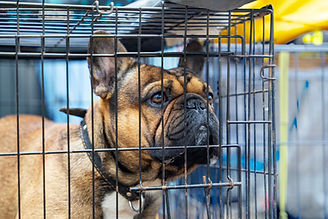How to Crate Train a Puppy
Bringing a puppy into your home is an incredibly exciting time! However, it is important to understand your pup’s needs and be prepared for it to come home. As den animals, dogs are naturally drawn to small and cozy places to sleep. Investing in a crate can help provide them with the security they are looking for and give them a safe place of their own. Although buying a crate may seem pricey at first, when you look at what you might have spent on replacing chewed-up furniture or rugs due to lack of crate training, purchasing one quickly pays for itself! Learning how to crate train a puppy and start acclimating the crate from day one so that they feel secure in their new environment. Kennel training can make potty training easier, gives you and your puppy a few breaks throughout the day and helps keep your puppy safe when you can’t watch him or her!
How to Crate Train a Puppy / Step by Step
Picking Out the Crate
Picking the right crate for your dog can be a crucial choice - it needs to be both comfortable and secure. Enclosed plastic crates are terrific for dogs who like darker, quieter sleeping environments, while collapsible wire crates are often a popular option. However, size is key when it comes to choosing the perfect crate for your furry friend!
Create the Right Atmosphere
Creating a comfortable and enjoyable environment for your pup is essential for them to appreciate their crate. Start by adding some soft blankets to the crate, making it an inviting place for your pup to rest. Don’t forget to throw in their favorite toys to really try and excite them about using the crate. Some dogs may prefer a dog bed instead of blankets, but don't be surprised by accidents as many dogs view the bed as a place to go to the bathroom. When selecting a spot for your pup's crate, focus on where you spend the most time in such as the living room or family room. And be sure to choose a spot close enough to an outdoor exit - that way your pup can get outside quickly when they need to go potty before having the chance inside the house. That way you won't have any accidents!
Getting Your Puppy to go Inside
To get your dog to become comfortable with a crate, patience is essential. Most reputable breeders will start crate training before pups go home ( and give plenty of instructions on how to crate train a puppy) which will make the transition much easier. But no matter how much previous exposure your puppy has had always start slow - open the crate door and place some treats on the floor near the entrance. Then, toss some treats inside and let your pooch investigate in their own time, there's no rush for them to enter. Some dogs go straight in while others may take awhile to feel comfortable enough; either way, never force them in. Make sure the crate door stays open for now, and if your dog looks ready you can try feeding inside the crate moving the food dish further back each mealtime. With gradual progress and plenty of love, your pup will soon be happily snuggling up inside their crate!
Spending Time In The Crate
Now that your dog is comfortable eating meals in the crate, it's time to start closing the door while they eat. Start by only closing it until they've finished the meal, and then gradually increase the amount of time that you leave it closed after mealtime. Your pup might whine for you to let them out, but stay persistent; only open the door when they stop whining. If you give in and let your dog out before this happens, they’ll think that whining is how to get out of the crate. It might be a challenge at first, but with patience and caring consistency, your pup will learn not to whine when left in the crate. Once your dog is comfortable in their crate, you can start leaving them there for short periods of time when you have to go out. This will set the foundation for your pup's newfound independence and they will learn to trust that you will be back soon and that the crate is a safe place.



